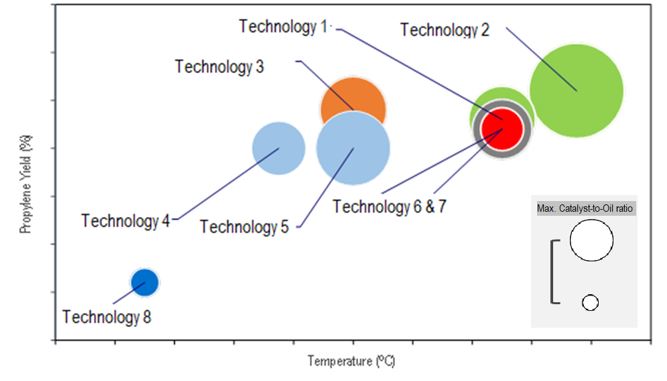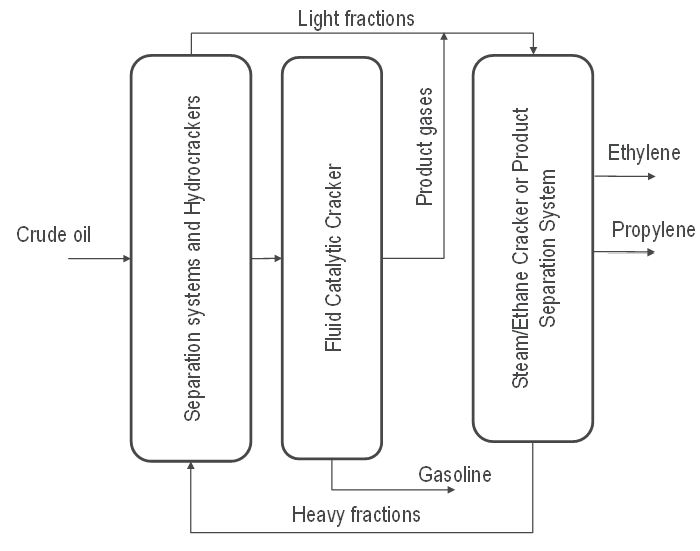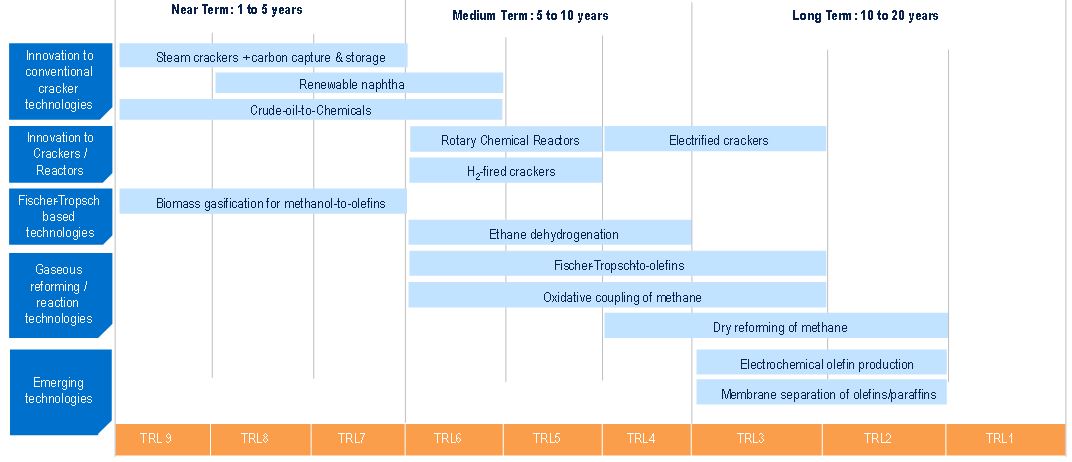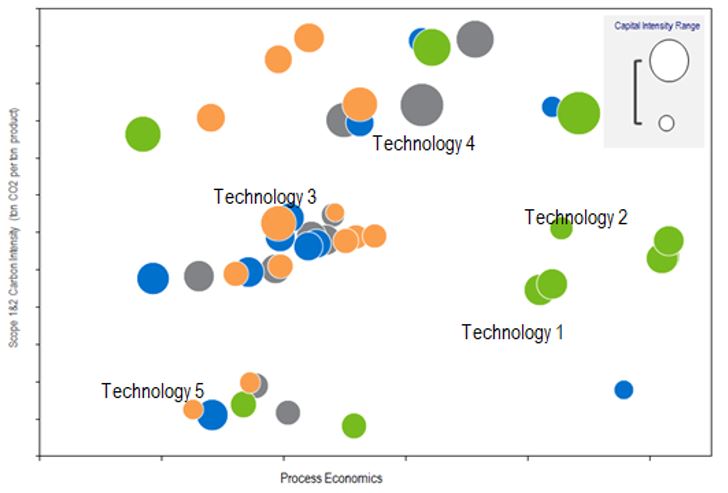Technology development for olefins: Shifting from fuels to chemicals and integrated plants

Due to improvements in fuel efficiency, decarbonization or electrification of the transportation sector, and the increasing value of chemicals, the demand for liquid fuels has been declining. The IEA has reported that the demand growth for oil to produce road transport fuels decreased from 1 to 0.6 million barrels per day between 2022 and 2023. By 2026, demand growth of approximately minus 0.1 million barrels per day is expected. This has prompted a shift in fluid catalytic cracker (FCC) operations from conventionally producing mostly gasoline, to producing higher value chemicals with the aim of improving operating margins. The major chemical produced from FCCs is propylene, which is used to produce several key derivatives including polypropylene for packaging as well as automobile body parts. In addition to altering operating conditions the geometries of FCC have been modified to improve the gas-solid interaction rates, such that the catalyst, solid and gas contact is optimized to maximize propylene production.
Propylene Yield from Different Technologies with respect to Operating Temperature and Catalyst-to-Oil Ratio
Propylene Yield from Different Technologies with respect to Operating Temperature and Catalyst-to-Oil Ratio
For FCC units shifting production emphasis from fuels to chemicals, an integration of refineries with petrochemical plants can be economically feasible so that the plant has the flexibility to co-produce propylene and ethylene, another olefin that serves as a chemical building block for other derivatives. These integrated, crude oil-to-chemical (COTC) plants were initially started in 2018-2019 by China’s private and state-owned companies with a combined capacity of 6.7 million tons per year of chemical products in 2022. A more recent development in COTC is S-Oil’s Shaheen Project in South Korea, which uses Lummus Technology’s Thermal Crude-to-Chemicals (TC2CTM) process capable of producing 3.2 million tons per year of chemicals. Construction of the plant is currently in progress, though no start-up date has been announced.
COTC plants integrate the FCC with steam crackers. Conventionally, FCC produces gasoline and propylene, and steam crackers crack naphtha to produce ethylene and propylene. Through a COTC plant, gasoline is still produced from the FCC, but the product gases from the FCC are fed to the steam cracker. The product gases are mixed with other light fractions produced from a front-end crude oil separation or hydrocracker section. This mixture is fed to the steam cracker to co-produce ethylene and propylene. Heavy fractions from the steam cracker are recycled back to the front-end separation or hydrocracker section. Through this integrated COTC configuration, operators have the flexibility to co-produce gasoline, ethylene and propylene to capitalize on changing market conditions.
Simplified Block Flow Diagram of Crude Oil-to-Chemicals Plant
(configuration is a generalization of the COTC concept and may differ with plants)
Simplified Block Flow Diagram of Crude Oil-to-Chemicals Plant
Achieving Sustainability Agenda
In addition to increasing chemical production and yields of olefins, sustainability concerns and pledges of carbon neutrality have also increased decarbonization initiatives, with significant activities related to the integration of plants with carbon capture and storage systems, hydrogen firing, and electrification of crackers. There has also been an increase in announcements by several major players related to the conversion of plastic wastes to olefins to improve circularity and reduce carbon emissions.
Some of the major technology developments under evaluation by technology providers and producers include hydrogen firing, integration with carbon capture, rotary type chemical reactors, COTC, ethane dehydrogenation, membrane separation of olefins and paraffins, oxidative coupling of methane, and other bio-based processes. However, not all approaches are commercially feasible today and an understanding of the Technology Readiness Level or TRL of these developments is crucial in planning for sustainable operations in the short term and longer term.
NexantECA’s Technology Readiness Level Assessment and Timelines
NexantECA’s Technology Readiness Level Assessment and Timelines
Bio-based Processes
Bio-based processes are known to have lower carbon intensity, as bio-feedstocks are often considered carbon neutral, resulting in lower carbon intensity compared to conventional methods of production. Bio-ethylene can be produced from bio-based feedstocks through dehydration of ethanol derived from first- or second-generation biomass. With bio-ethylene, the value chain of key derivatives can be decarbonized. Bio-ethylene can be polymerized to produce bio-based polyethylene or oxidized to produce a bio-based ethylene oxide, which are subsequently used to produce a bio-based mono ethylene glycol (MEG). MEG is used for the manufacture of polyethylene terephthalate (PET) bottles. Other bio-ethylene and bio-MEG technology that have potential for commercialization include:
Microbial reactions that capture and convert carbon dioxide from process off-gases to ethylene
Gasification of biomass or municipal solid waste for the production of methanol, subsequently used for a methanol-to-olefins plant
Electrochemical cells that convert carbon dioxide and water to ethylene and MEG
Direct conversion of bio-based feedstock to MEG.
Carbon Intensity and Production Economics
Short term solutions to reduce carbon intensity are focused on capturing carbon dioxide emissions and either sequestering carbon dioxide or converting carbon dioxide into useful products. Either abatement approach adds cost when compared to conventional olefins production routes. In many cases, the cost of abating carbon when producing olefins renders the overall process economically unfeasible. Developmental processes can be burdened with poor scale economics, high-cost raw materials or catalysts, and high conversion costs among other cost factors. Understanding how this impacts overall production economics and carbon intensity provides guidance for future investment.
NexantECA analyzes the carbon intensity and production economics of select technologies and regions for the production of ethylene, bio-ethylene, ethylene oxide, mono ethylene glycol and propylene and presents the decarbonization potential and the economic viability associated with them.
Example of Carbon Intensity with respect to Production Economics for Different Technologies
Example of Carbon Intensity with respect to Production Economics for Different Technologies
References: IEA. Oil 2023: Analysis and forecast to 2028.
The Author...
Dr. Mooktzeng Lim, Consultant
Find out more…
Technoeconomics – Energy and Chemicals: Ethylene (2023 program) provides an overview of commercial and developing technologies for the production of ethylene including decarbonization options for achieving low or net-zero emissions. The report includes a Technology Readiness Level (TRL) summary for the various decarbonization options. Technology and regional comparisons of cost of production and carbon intensity (scope 1 and 2) are presented, with breakeven carbon price analysis for representative crackers with carbon capture systems. Global ethylene capacity by producer is provided.
Technoeconomics – Energy and Chemicals: Propylene (2023 program) provides an overview of commercial and developing technologies for the by-product and on-purpose production of propylene, the second most used chemical in terms of global volumes after ethylene. By-product propylene technologies include naphtha cracking, conventional and enhanced fluid catalytic cracking (FCC) of vacuum gas oil and atmospheric residue. This is followed by on-purpose propylene technologies that include residual grade propylene fractionation, propane dehydrogenation, metathesis, olefins catalytic conversion/cracking and methanol-based processes. The technoeconomic and carbon intensity analysis of the technologies in four regions (Middle East, United States, Western Europe, and China) are discussed, with coal-based processes included for China. Emerging or developing technologies that have the potential to decarbonize propylene production are also discussed. Cash margins for the commercial technologies by regions are correlated to the carbon intensities (scope 1 and 2), with a breakeven carbon cost analysis for fluidized bed catalytic crackers that are integrated with carbon capture systems. Global propylene capacity by producer is provided.
Biorenewable Insights – Renewable Ethylene, Ethylene Oxide, Monoethylene Glycol (2023) investigates the various commercial and developmental routes for the production of renewable ethylene. Technologies based on bio-ethanol, bio-naphtha, and bio-methanol are investigated for ethylene production, as well as sugar and glycerin-based routes directly to ethylene glycol. Pyrolysis oil from thermal conversion of plastic wastes has seen significant development for conversion into bio-naphtha feedstock, as well as gasification of biomass to produce methanol for ethylene production. Dry reforming of methane with carbon dioxide and electrochemical production of ethylene are the new technologies covered in this edition of the report. Cost of production models, process descriptions, capacity analysis and implications for the conventional industry are included.



